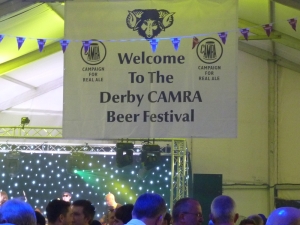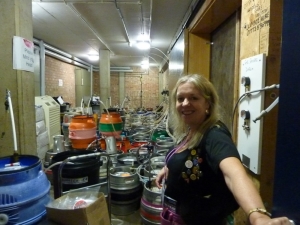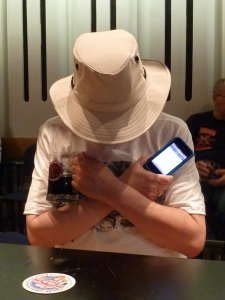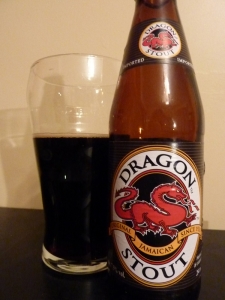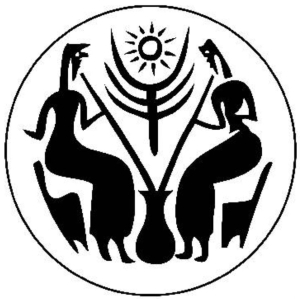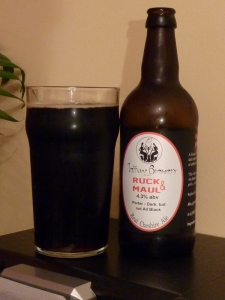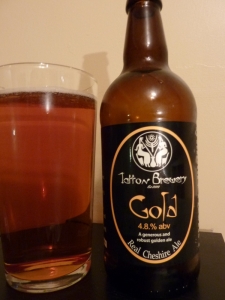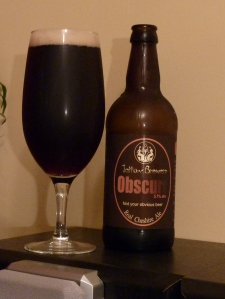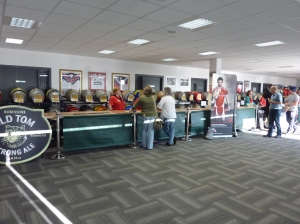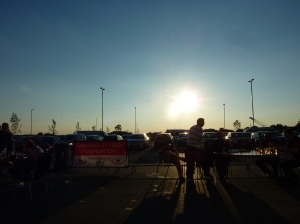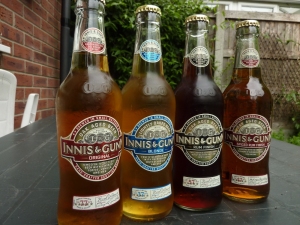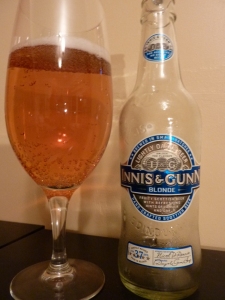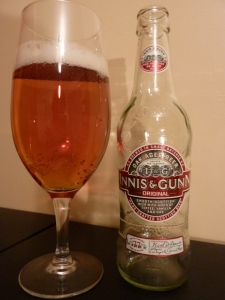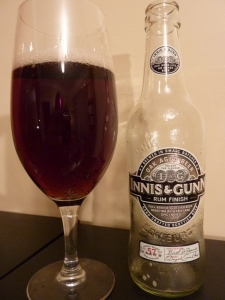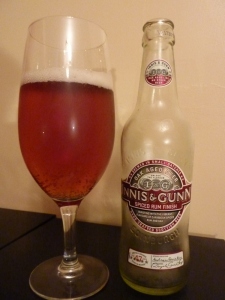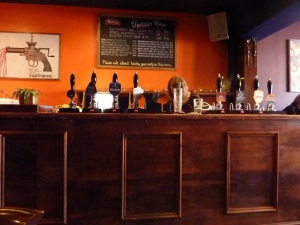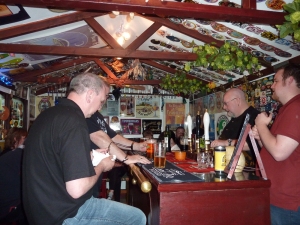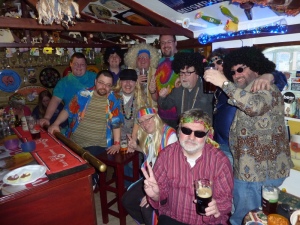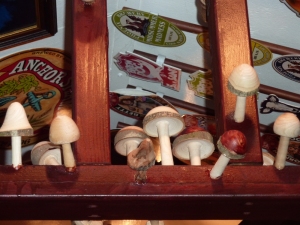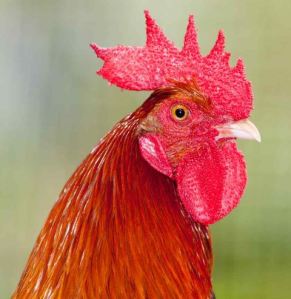
A cock
I have an old, yellowed, second-hand book on my beer shelves. It’s called “Amateur Winemaking & Brewing”, and is a Teach-Yourself book published in 1974. The focus is clearly on winemaking, as of the book’s 271 pages, only the final seven are dedicated to beer recipes. There are nine, and the last one is for Cock Ale. Now we’ve all heard of cock ale, it’s something to snigger about when a beer or two too many has regressed you to schoolboyhood.
The book describes a method for making a 4 gallon batch of what it calls ‘full-bodied and strong beer’. I’ve never made it, but I suspect that ‘strong’ in 1974 probably meant anything over about 4%. To make the cock ale, it suggests that when the specific gravity has fallen to 1010, 1 pint of grape concentrate be added to the fermenting wort, along with 1 lb of ‘chicken giblets, scraps, etc. (cooked)’ placed in a net. I should point out that the parenthetical ‘cooked’ is very important. The beer, it goes on to say, should be bottled when the specific gravity reaches about 1006.
To quote directly from the book; ‘Although the presence of the chicken scraps does give the beer flavour and body, the idea is not to everyone’s taste’. Quite.
I decided that this recipe seemed rather watered-down from what may well have been a much more ‘interesting’ original recipe, so I dug a little deeper.
The first known reference to cock ale is in the 1669 book “The Closet of the Eminently Learned Sir Kenelme Digby Kt., Opened”. I quote from the opened closet:
‘Take eight gallons of ale, take a cock and boil him well, then take four pounds of raisins of the sun, well stoned, two or three nutmegs, three or four flakes of mace, half a pound of dates; beat these all in a mortar, and put to them two quarts of the best sack*; and when the ale hath done working, put these in, and stop it close six or seven days, and then bottle it, and a month after you may drink it.’
*sack = a sort of white sherry.
Mmmm… this looks lovely. And have you noticed in old recipes they always used massive quantities – “Take eight gallons of ale…”
In 1726, this recipe was given by John Nott, the Duke of Bolton’s cook, in his “Cooks and Confectioner’s Dictionary”:
‘Take a couple of young cocks, boil them almost to a jelly in water, and put into four gallons of ale; put in also a pound of raisins of the sun stoned; infuse a pound of dates, mace and nutmegs, of each two ounces, in a quart of canary*; put them to the ale; strain and squeeze out the liquor, and put to it half a pint of new ale yeast. Let it work for a day; you may drink it the next but it is better the third day; you may make it weaker by mingling it with plain ale as you draw it, or you may put it into a firkin of ale. It is good against consumption and to restore decayed nature.’
*canary = another name for sack.
This looks to me like a version of the first recipe written down by someone who had actually made it. It’s also one of my favourites because not only does it mention ‘cock’, but also ‘firkin’. Fnarr, fnarr.
In her 1727 cookery book, “The Compleat Housewife, or, The Accomplish’d Gentlewoman’s Companion”, Eliza Smith goes for the massiveness record with this by now quite familiar recipe:
‘Take ten gallons of ale, and a large cock, the older the better; parboil the cock, flay him, and stamp him in a stone mortar till his bones are broken (you must craw and gut him when you flay him); then put the cock into two quarts of sack, and put it to three pounds of raisins of the sun stoned, some blades of mace, and a few cloves; put all these into a canvas bag, and a little before you find the ale has done working, put the ale and bag together into a vessel; in a week or nine days time bottle it up; fill the bottle but just above the neck, and give the same time to ripen as other ale.’
I have seen this particular recipe quoted on the internet, but instead of “flay him” it has been typed as “flea him”. Do not under any circumstances attempt to flea your cock.
In “Homebrewed Beers and Stouts” by that doyen of mid-20th century homebrewers, C. J. J. Berry (1977), the adventurous Cyril modified this original recipe and brewed an experimental one gallon batch. On tasting the result, he wrote: ‘Astonishingly, it made an excellent ale, nourishing and strong-flavoured, of the ‘barley wine’ type; well worth trying.’
More recently, Chris Thomas and Adam Cusick reported their own experiments with cock ale in Beer & Brewing Magazine (Australia). Their recipe was quite modified to cater for modern tastes, but included the all important cooked chicken, which they got from a supermarket. So technically it was more likely to have been hen ale.
They report: ‘At one month the beer showed great potential. It poured a dark amber colour with a foamy head. Howard was offered the first taste of the Cock Ale and was rapt with the added bitterness of the bullet hops and impressed by the obvious benefits of a quality yeast. He also recognised the superior head. And thankfully it didn’t taste like drinking a roast chicken!
‘In terms of aroma, the cloves are first identifiable, along with the pleasant hint of oak from the dry white. The spices, raisins and wine really enhance the flavour of this freshly hopped strong ale, while the major impact of the chicken has been to add great body to the beer.
‘Two months later, the second tasting reveals the beer to have matured into what Berry accurately described as an ‘excellent ale’! While the hops have mellowed nicely, the distinctive spices remained. The beer shared distinct similarities with a strong Belgian ale.’
The recipes from the 17th and 18th century are remarkably consistent. It may have been commonplace to chuck kitchen scraps into whatever happened to be fermenting away in a corner, and by happy accident, someone discovered that an old cock is just what beer needs to liven it up.
I’m tempted, almost, to try it myself. It’s not only the presence of meat in the ale (guff, guff!), but also the odd spices – mace and cloves – that I find intriguing.
Go on – someone give it a go and let us know how it turned out. You can write it up and I’ll publish it as a guest blog. Ah, go on. Go on, go on, go on, go on, go on!
Words are my copyright, please respect that. All you have to do is ask. Thank you.

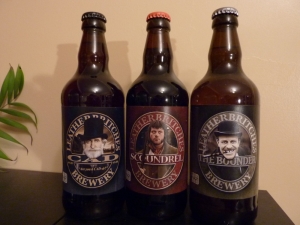 These three bottles were all bought in a shop in Ashbourne, and are attractively labelled with images of fictional Rotters.
These three bottles were all bought in a shop in Ashbourne, and are attractively labelled with images of fictional Rotters. 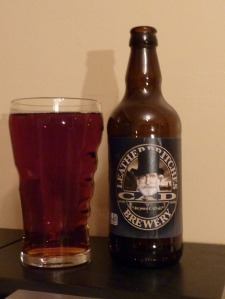 Let’s start with Leatherbritches Cad. I’m sure I should know the face that looks out from the label, I know the other two, but I’m afraid I don’t recognize this one. If you can enlighten me, please leave a comment below. (See comment below!) Cad is a 4.0% brown ale, perhaps a best bitter. On the face of it, this is a fairly straightforward beer. There are bags of dry malt to start with followed by a hoppy finish. You have to dig a bit for the subtler tastes. There’s a touch of toffee in there, and the more you get down the glass, the more prominent becomes the roasted flavour in the malt. The malt certainly dominates here. The beer is drinkable and good, but perhaps lacks a bit of excitement.
Let’s start with Leatherbritches Cad. I’m sure I should know the face that looks out from the label, I know the other two, but I’m afraid I don’t recognize this one. If you can enlighten me, please leave a comment below. (See comment below!) Cad is a 4.0% brown ale, perhaps a best bitter. On the face of it, this is a fairly straightforward beer. There are bags of dry malt to start with followed by a hoppy finish. You have to dig a bit for the subtler tastes. There’s a touch of toffee in there, and the more you get down the glass, the more prominent becomes the roasted flavour in the malt. The malt certainly dominates here. The beer is drinkable and good, but perhaps lacks a bit of excitement. 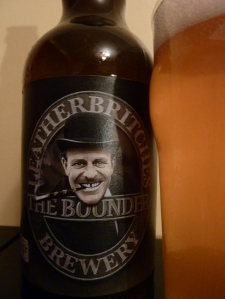 Leatherbritches Bounder sports an image of Terry-Thomas playing… well, just about every character he ever played. The label describes this beer as a ‘Premium Extra Pale Ale’. I hate that word ‘premium’ as used by brewers. It’s just a noise, it means nothing. All it does is fill a small space on the label. The rest is accurate enough, this is a very pale beer. It’s lively and pours with a foamy off-white head. The taste is smooth, floral and fruity with a tiny hint of cream and a nice dry bitter finish. Although the same ABV, 4.0%, I found that Bounder is better than Cad, definitely.
Leatherbritches Bounder sports an image of Terry-Thomas playing… well, just about every character he ever played. The label describes this beer as a ‘Premium Extra Pale Ale’. I hate that word ‘premium’ as used by brewers. It’s just a noise, it means nothing. All it does is fill a small space on the label. The rest is accurate enough, this is a very pale beer. It’s lively and pours with a foamy off-white head. The taste is smooth, floral and fruity with a tiny hint of cream and a nice dry bitter finish. Although the same ABV, 4.0%, I found that Bounder is better than Cad, definitely. 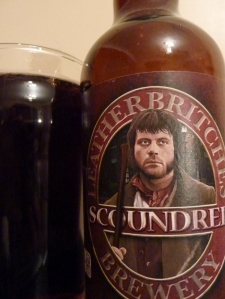 Leatherbritches Scoundrel has the late massive boozer Oliver Reed on its label. Ollie is seen here in his younger days when he was indeed a dashing and handsome fellow. Here he appears in his role of Bill Sykes in Oliver!, the musical adaptation of Dickens’ novel Oliver Twist. The beer is described on the label as a ‘Premium (oh dear) Dark Ale’. Yes, it’s dark, pouring an attractive deep red colour. It’s just a tad stronger than the other two at 4.1%. The head is a little thin, but that means little. The first impression is that this beer is quite sweet. There’s clear roasted malt, too with a slight hint of treacle, or possibly caramel. Nice and drinkable, but again, it lacks a certain excitement. I wouldn’t condemn any of these beers, in fact I would say that they are all pretty good, but if pressed to make a choice, I would plump for Bounder over the other two.
Leatherbritches Scoundrel has the late massive boozer Oliver Reed on its label. Ollie is seen here in his younger days when he was indeed a dashing and handsome fellow. Here he appears in his role of Bill Sykes in Oliver!, the musical adaptation of Dickens’ novel Oliver Twist. The beer is described on the label as a ‘Premium (oh dear) Dark Ale’. Yes, it’s dark, pouring an attractive deep red colour. It’s just a tad stronger than the other two at 4.1%. The head is a little thin, but that means little. The first impression is that this beer is quite sweet. There’s clear roasted malt, too with a slight hint of treacle, or possibly caramel. Nice and drinkable, but again, it lacks a certain excitement. I wouldn’t condemn any of these beers, in fact I would say that they are all pretty good, but if pressed to make a choice, I would plump for Bounder over the other two.
